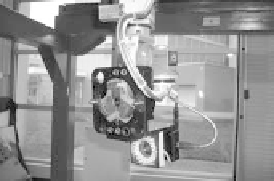Information Technology Reference
In-Depth Information
Fig. 5.8
Camera and light-ring mounted on the robot end-effector
5.4.1.3
Behavior with respect to Partial Occlusions
The third experiment deals with partial occlusions. The desired object pose as well
as the initial pose are still unchanged. After having moved the camera to its initial
position, an object has been added to the scene, so that the initial image is now
the one shown in Figure 5.5(a) and the desired image is still the one shown in
Figure 5.3(h). Moreover, as seen in Figures 5.5(b-c), the object introduced in the
scene is also moved by hand during the camera motion which highly increases the
occluded surface. Despite that, the control law still converges. Of course, since the
desired image is not the true one, the error cannot vanish at the end of the motion
(see Figure 5.5(e)). Nevertheless, the positioning error is not affected by the oc-
clusions (see Figures 5.5(h-i)) since the final positioning error is
r
= (-0.1 mm,
2 mm, 0.3 mm, 0.13 deg, 0.04 deg, 0.07 deg). It is very similar with the previous
experiments. Compare also Figure 5.3(d) with Figure 5.5(h) and Figure 5.3(f) with
Figure 5.5(i), the positioning error, and thus the camera trajectory, are really not af-
fected by the occlusions. This very nice behavior is due to the high redundancy of
the visual features we use.
Δ
5.4.1.4
Robustness to the Depths
The goal of the last experiment is to show the robustness of the control law with
respect to the depths. For this purpose, a non planar scene has been used as shown
on Figure 5.6. It shows that large errors in the depth are introduced (the height of
the castle tower is around 30 cm). The initial and desired poses are unchanged. Fig-
ure 5.7 depicts this experiment. Here again, the control law still converges (despite
the fact that the interaction matrix has been estimated at a constant depth
Z
∗
=80
cm) and the positioning error is still low since we have
Δ
r
=(0.2 mm, -0.0 mm,
0.1 mm, -0.01 deg, 0.00 deg, 0.06 deg).
5.4.2
Positioning Tasks under Complex Illumination
In this section we consider the more complex case when the temporal luminance
constancy is no more valid. Indeed, the scene is no more illuminated by a
diffuse lighting since a directional light-ring is located around the camera lens

Search WWH ::

Custom Search